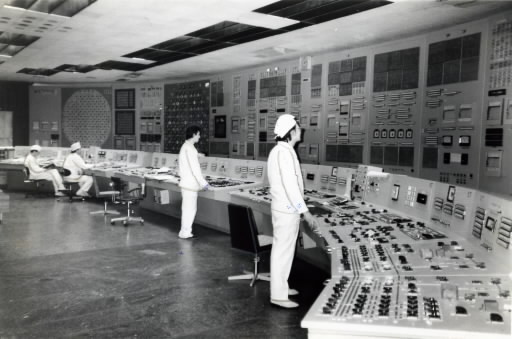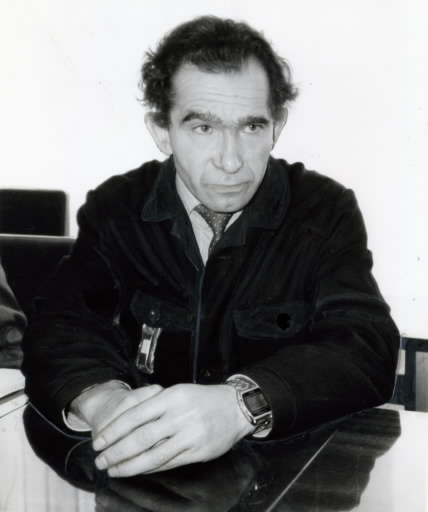3. Visiting the Site of the Accident
Jan. 22, 2013
Chapter 2: Soviet Union
Part 2: Chernobyl Three Years After
Part 2: Chernobyl Three Years After
As we drew closer to the plant at Chernobyl, the needle on the radiation detector recorded increasingly larger amounts of radioactivity. Even though we had anticipated this, it was difficult to remain calm. At Kiev, about eighty miles from the site of the accident, the instrument had registered 0.01 to 0.02 milliroentgens. When we reached the eighteen-mile checkpoint, the reading was 0.06 to 0.08 milliroentgens and at the six-mile checkpoint, 0.20 to 0.25. Inside the control rooms for reactors No. 1 and 2, we recorded 1.00 to 1.50 and then, 210 yards from the site of the explosion, the needle jumped to 3.00 and 5.00 milliroentgens.
Radiation cannot be detected by any of our five senses. We can only be aware of its presence and potential danger through the use of special detection equipment. It is often said that radiation shows no mercy; medical experts agree that even relatively minor doses of radiation can have a harmful effect on the body.
However, the Soviet government took a different view. Although reactor No. 4 was destroyed, the government decided that if reactors Nos. 1, 2, and 3 could be cleared of contamination, they could be used again. By the end of 1986, eight months after the accident, reactor No. 4 had been sealed up and reactors Nos. 1, 2, and 3 had been brought back into operation.
Our guide in the control room for reactors Nos. 1 and 2, Mikhail Umanets, who took over the job of plant manager after the accident, assured us that the lessons of the tragedy had been learned. According to him, the control rods were now better positioned, there was now increased stability at low output levels, and the emergency shutdown facilities had been improved. All these changes concerned technical problems; we wondered if the same care had been taken regarding the health of employees exposed to radiation.
We were able to observe new safety measures in force at the city of Slavtiti, thirty miles to the east of Chernobyl. Slavtiti, which now has a population of twelve thousand, was built to replace Pripyat, the town abandoned after the accident. Its sole connection with the plant is by four railway lines, two each going to and from the site. There is no other method of commuting to the site, the idea being to provide a means of sealing off the new town in case of the threat of radioactive contamination.
The deputy mayor of Slavtiti, Sergei Bitulin, who was himself exposed to radiation at the time of the accident, explained the procedure that the workers must follow each day on their way to and from the plant.
Each morning on arrival at Slavtiti Station, the workers change into special clothing for commuting and board the train. When they are within eighteen miles of the site they stop at a midway station, change once again, and then get on a special train which runs only in the vicinity of the plant. At Chernobyl Station they change into yet another set of clothes and enter the grounds of the plant. Altogether the employees must make six changes of clothing going to and from the plant and they are checked for radiation at each stage.
The measures taken to protect employees are not confined to these changes of clothing. Staff work on a shift basis—two weeks on and then two weeks off. Government regulations have been introduced which in theory limit lifetime exposure to radiation to 35 rems. However, whether this is effective in practice or not is another matter.
The government has put three of the reactors back into operation even though it is aware of the possible adverse effects on the employees' health, and large sums of money have been spent on the cleanup operation and building of the new town. This would seem to indicate that there has been no change in the Soviet Union's atomic energy policy, yet at the end of 1988, and in April 1989, the Soviet government halted construction of a total of ten new reactors, including Chernobyl Nos. 5 and 6, which were already eighty-five percent complete. The government's insistence that there has been no change in atomic energy policy would appear then to be far from the truth.
Chernobyl was under very tight security. After being checked for radiation, the security guard led us into the brightly lit control room, keeping a watchful eye on us all the while. We had asked the manager if we could meet someone who was working in the plant at the time of the accident, and Vladimir Tyugliv, foreman at the No. 2 reactor, was sent to greet us. Umanets, the plant manager, appeared at his side and said, "Here's your man, ask him anything you like."
A man of solid build with penetrating eyes, Tyugliv is one of the longest-serving employees at the plant, having been there since 1975, two years before reactor No. 1 had reached critical temperature and gone into operation. He was a graduate of Gorki University, majoring in nuclear physics, and was every inch the technician in his manner. On his navy blue work clothes he wore a film badge to detect radiation, though he did not appear to be very concerned about any danger.
"There's no point in being frightened of radiation. We can't see or feel it, but we don't let that worry us—no way. It's our job to find the best ways to coexist with it." The plant manager nodded in agreement.
When we brought up the subject of the disaster, however, the foreman evaded our questions, insisting instead that No. 4 was safely sealed in its concrete "coffin," and that Nos. 1 to 3 were in perfect working order.
When the explosion occurred, Tyugliv was at his home in Pripyat. He rushed to the plant and assisted in the attempts to cool down the No. 3 reactor, which backs onto No. 4. At dawn he returned home and, after resting for a short while, helped in the evacuation of the forty-five thousand residents of Pripyat. Returning the next day to the accident site, he investigated the damage to No. 4. Tyugliv remembers having a slight headache and feeling nauseous at the time. Later he was hospitalized and found to have been exposed to a radiation level of 490 rems—Level 3 in intensity on the government scale. The tone of his voice as he told us this gave no indication that he was worried about the huge dosage he had received.
Of the twenty-two workers diagnosed as having been exposed to a radiation dosage of Level 4 intensity (600 to 1,600 rems), only one is still alive. Of the twenty-three diagnosed as Level 3 cases like Tyugliv, seven have already died. One of these men was Anatoli Citinikov, who was forty-five years old at the time. He had worked alongside Tyugliv for many years.
"He was a marvelous technician," commented Tyugliv. "Unfortunately he was inclined to be sickly... I was in a terrible way myself, what with losing all my hair. But in August it started to grow back, and by autumn it was back to normal.
"Can you believe that there wasn't a strand on my head after the accident?" he said, running sturdy fingers through his chestnut-colored hair to show how thick it was.
Tyugliv seemed very calm and spoke without any great emotion. The manager, who was standing beside him, seemed satisfied with what he was saying.
"At the time of the accident, there were four thousand people working at Chernobyl. Of these, eleven hundred have returned here to work, including ten who were hospitalized. Tyugliv here was one of those—he's indispensable for the operation of the plant." According to Umanets, Tyugliv came to him six months after the accident and asked if he could start work again. Leaving his wife and son in Kiev, he rented a house twenty-five miles away and returned to his post. In December 1986, two months after Tyugliv started back at the plant, reactor No. 3, which backed onto the concrete-encased No. 4, was brought back into operation.
Umanets proceeded to give us a long and detailed explanation of the plant's operations after the accident. He himself was brought in to replace Bulkhanov, the manager at the time of the accident. Bulkhanov was dismissed from his post and sentenced to ten years' loss of freedom.
Following this rather frustrating session in the manager's office, we met with Mr. Ilyin, vice president of the Soviet Academy of Medical Sciences in Moscow. In our discussions he stated quite clearly that under the laws enacted since the accident, a person exposed to more than the lifetime limit of 35 rems of radiation was forbidden to work at a nuclear power plant. If this was the case, then Tyugliv's presence at Chernobyl was clearly illegal. The glaring differences between government regulations and what is really happening in the areas concerned could not have been made more blatantly obvious and illustrate well the general state of affairs in the Soviet Union three years after the accident at Chernobyl.









